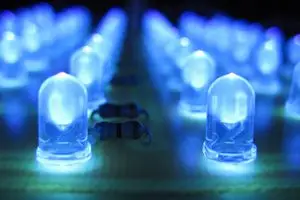When calculating the amortization of LED lamps compared to other alternatives (typically incandescent or fluorescent), one of the most important parameters is the useful life of the lamps. LED lamps are generally more expensive than other alternatives, so a significant part of the justification for their profitability lies in their longer useful life, which results in lower replacement costs and maintenance expenses.
The difference with the rest of the parameters involved in the amortization (price, electricity consumption, and amount of light provided) is that the useful life is not directly measurable immediately after acquiring the lamp. We have no way to verify that the data provided is accurate, so we are required to trust the manufacturer’s “good faith.”
This post, like the rest of the blog, is written as objectively as possible, recognizing the virtues and flaws of each technology. After all, I don’t benefit from you buying LED or compact fluorescent lamps. As I always tell you, don’t fully believe the data provided by those trying to sell you a product, an energy audit, or, in general, anyone with economic interests.
It’s also worth noting that not all manufacturers are the same. Generally, the salespeople from prestigious brands tend to have a high degree of honesty when expressing the characteristics of their products, even when it’s detrimental to their product. However, other brands are not as interested in protecting their brand and promise the world just to sell more.
Doesn’t it seem strange to you that quality manufacturers (Philips, Osram, etc.) indicate a shorter lifespan on their lamps than alternatives that cost 2 to 3 times less, or those bought at a cheaper store? Always be wary of bargains.
Truths
LEDs are encapsulated in plastic that is exceptionally durable. They are also highly resistant to external agents. A correctly manufactured and optimally functioning LED can reach a useful life of up to 100,000 hours.
In addition, unlike conventional lamps that have a useful life after which they stop working (burn out), LEDs do not have, in theory, reasons for a failure that results in complete shutdown.
On the contrary, LEDs undergo a progressive degradation process. That is, as time passes, they progressively provide a lower amount of light. The useful life usually provided for an LED is the time for which the amount of light provided by the lamp decreases to 70% of its nominal value. The relationship between time and degradation is not linear, as the degradation speed increases over time.
So, for now in this section, a positive point for the LED.
What they don’t tell you
Influence of temperature
The operating temperature is one of the most important factors in its useful life. Both the ambient temperature and the junction temperature (internal to the LED) reduce the LED’s life, with the latter being particularly critical. A 25°C increase in the junction temperature causes the useful life of an LED to decrease from 50,000 to 16,000 hours.
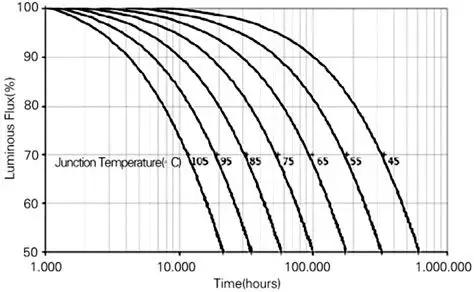
70 to 80% of the energy generated by an LED is converted into heat, which needs to be dissipated by the luminaire. This is why LED luminaires have large heat sinks on the back. A proper design of the heat dissipation system is essential for a good lamp life.
Influence of intensity
Increasing the electrical intensity through the LED also reduces its useful life. Furthermore, although it increases the amount of light emitted, it reduces its luminous efficiency, that is, the amount of light emitted in relation to its electrical consumption. A correct design of the lamp’s electronics is necessary to maintain the electrical intensity constant and at the optimal value required by the LED.
Operating conditions
The values provided for the useful life and efficiency of LEDs are determined under the so-called laboratory conditions, that is, constant temperature of 25°C, in a clean environment, in complete absence of vibrations, environmental factors, and solar radiation. These conditions are very different from the conditions the lamp will be subjected to in real operating conditions.
Manufacturing defects
Manufacturing LEDs requires high-purity semiconductor materials, similar to those used in the electronics industry. However, it is impossible to have perfectly pure materials; there is always a small percentage of impurities that affect the LED’s useful life.
Achieving a higher degree of purity and reducing the percentage of inclusions requires complex and expensive manufacturing facilities and processes. Therefore, it is logical to expect that a cheap LED has a much lower component purity than those from recognized and higher-quality manufacturers.
Defects in other components
A very important factor that often goes unnoticed is the need for all lamp components, especially the electronics accompanying the LED, to also be of quality.
Most of the “burned out” LEDs are not actually due to a failure of the LED itself, but to a failure in the electronics. In many cases, it is a simple failure in one of the solder joints, which breaks due to vibrations or expansions. These failures cannot be repaired on-site and require sending the lamp back to the factory, where it can likely be repaired.
Lamps with multiple emitters
LED lamps are actually made up of several individual LEDs. Let’s see the effect this grouping has on the life of a lamp. I will keep the level of mathematics as low as possible and avoid using terms like standard deviation or Weibull distribution. So, if anyone (like me) likes statistics, don’t send me horse heads keep that in mind.
Let’s take all the previous factors and synthesize them into a simulation of the probability of LED failure over time. We will simulate two experiments, each consisting of 100 individual LEDs. Each LED will have an average life of 35,000 hours, which is an appropriate value, although the results are extrapolatable to any other average life.
We’ll bring the results to what we’ll call a survival graph. Logically, the LEDs do not fail simultaneously after the average life. In reality, they fail randomly, at time values more or less concentrated around the average life. The graph shows on the Y-axis the percentage of LEDs that have failed after the number of hours shown on the X-axis.
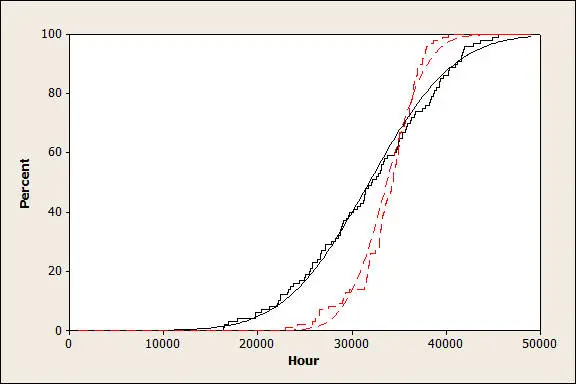
The first thing we notice is that the red graph is “harder” than the black one. The LEDs from the red experiment mostly last up to 35,000 hours, and the failure occurs near this time. However, the LEDs from the black experiment have a less concentrated distribution, with some failures occurring earlier. In return, there are some that exceed the average life, so the average life of both experiments is the same.
Now, let’s simulate 5 series of experiments for lamps consisting of 1, 3, 5, 10, and 20 LEDs. We have adopted the curve of the red experiment because, being “harder,” it is more beneficial for the LED. In each series, 100 lamps will be simulated. The following graph shows the time until the occurrence of the first failure.
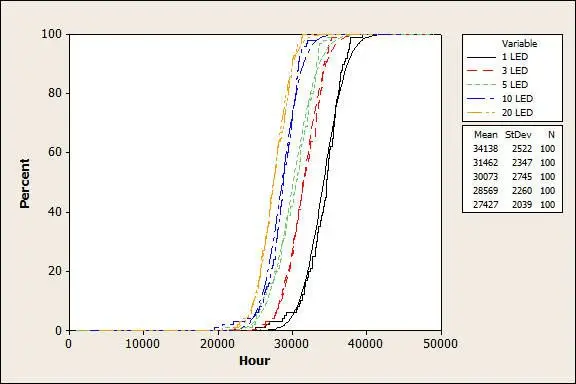
It is observed that the life of the lamp decreases as the number of LEDs it comprises increases. This is because, as mentioned, not all emitters fail simultaneously. Instead, they have a probability of failure around the average life.
The effect of this reduction is much greater when the dispersion of the LED failures is greater, that is, when the individual LED survival graph is “softer.” This is because, as we have seen, in a less concentrated graph, it is more likely that failures will occur at times much lower than the average life.
Well, so many graphs and so much mathematics to justify a simple and obvious reality. In a group of several light emitters, the time until the first failure is substantially lower than the average life.
Now the question is, how many LEDs have to fail in a lamp before considering that its replacement is necessary? One, two…? 10% of those that make up the lamp? The answer depends on each user, but personally, for me, no burnt out LED is acceptable.
Conclusion
For a manufacturer to say that their LED lasts for 30,000 hours, it only provides part of the information. It does not give information about the distribution dispersion, nor about the influence of the rest of the components and factors. Furthermore, this is a value obtained under laboratory conditions, with controlled temperature, in the absence of vibrations, etc.
Now take this LED, put it in a street lamp, with passing vehicles, rain, solar radiation, expansions and contractions caused by temperature changes (for example, between day and night), along with the probability of failure of other components (electronics and solder joints), and the fact that lamps are made up of several emitters, and see what that average life is reduced to.
It’s something simple to understand, which apparently those who have replaced all the traffic light lamps didn’t know, arguing improvements in energy efficiency and cost savings, and less than two years later, half of the traffic lights have one or more LEDs turned off.
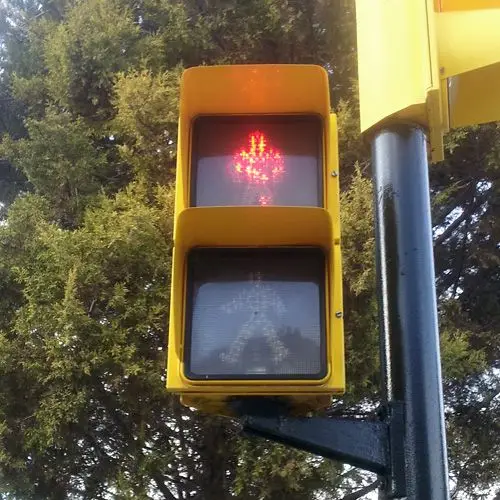
Another example I can tell you about firsthand happened in a certain municipality where several high-efficiency sodium vapor luminaires were replaced with very cheap LED luminaires, between 2 and 3 times less than the competition. The manufacturer claimed to use a high-quality LED made in the USA, but a simple internet search showed signs that the manufacturer was commercializing a Chinese product on which they scraped off the name and put a label with their logo on it. Despite having advised the client against it, the brand’s salesperson must have been excellent at their job because they convinced the municipality to install their luminaires. In less than a year, the luminaires were burnt out, and the municipality received complaints that the lighting levels were much lower than those available previously, resulting in a lack of visual comfort. Needless to say, they did not comply with the regulations at all. This is what happens when things are done wrong and you bypass the recommendations of those who advise you correctly.
The solution to these cases is actually quite simple. Demand a guarantee from the manufacturer. If they are so sure about their product as to use those values in an amortization study, they should offer a warranty that covers at least 80% of the useful life. After all, they know their product quality and manufacturing process better than anyone else. Why should you risk your money in an uncertainty that is actually the manufacturer’s responsibility, and that they know much better than you?
My advice is that when conducting an LED amortization study, calculate its useful life as the warranty offered by the manufacturer, and in this way, avoid unpleasant surprises. And, as always, be wary of bargains.
